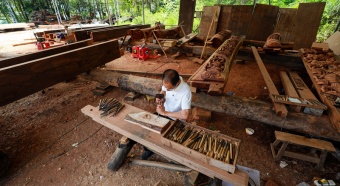For studying single-cell wound repair, researchers at Stanford University have created a new tool that is essentially an assembly line guillotine for cells.
According to a news release on Monday, the device pushes a row of cells down a tight channel onto a pointed knife blade, which cuts the cells evenly in half. The guillotine cuts Stentor coeruleus cells 200 times faster than the previous method with similar survival rates.
If cut in half, Stentor coeruleus, a single-celled, free-living freshwater organism, shaped like a trumpet and big enough to see with the naked eye, can heal itself into two healthy cells, making it a candidate for study on making self-healing materials and machines.
However, before researchers could work on the organism, they need a way to efficiently slice the cell in two.
Prior to the cellular guillotine, researchers hoping to study Stentor had to slice the cells by hand under a microscope, using a glass needle.
"Cutting a single cell by hand takes about 3 minutes if you're good at it, and even if you're good at it, you can't always cut the cell equally in half. This method has not changed for over 100 years," said Lucas Blauch, a graduate student and lead author of the study published in the June 27 issue of the Proceedings of the National Academy of Sciences.
"We knew that our lab's expertise in microfluidics would allow us to create a device to do that much faster," Blauch said.
Using the century-old cutting method, it would take a researcher five hours to cut 100 cells, and by the time they were done, the cells they cut first would be well on their way to healing. The guillotine built at the laboratory of Sindy Tang, an assistant professor of mechanical engineering at Stanford, could cut 150 cells in just over 2 minutes, and the cuts were much more standardized and synchronized in the stage of their repair process. The research team achieved this rate by creating a scaled-up version of their tool with eight identical parallel channels that run simultaneously.
Tang said her group is ready to study how the cells heal. "From the engineering perspective, we hope to be able to extract basic principles from our studies, and apply them to engineering design to make self-healing materials and machines," she said.









